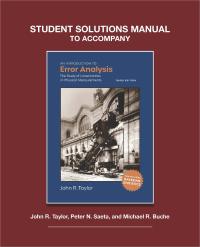Student Solutions to Accompany Taylor’s An Introduction to Error Analysis, 3rd ed
Student Solutions to Accompany Taylor’s An Introduction to Error Analysis, 3rd ed
By: John R. Taylor, Peter N. Saeta, Michael R. Buche
This detailed Student Solutions Manual accompanies our internationally lauded text, An Introduction to Error Analysis by John R. Taylor, which is newly released in its 3rd edition after sales of more than 120,000 print copies in its lifetime.
For all sales outside of the United States, please contact Felicity Henson, fhenson@aip.org
Title information
This detailed Student Solutions Manual accompanies our internationally lauded text, An Introduction to Error Analysis by John R. Taylor, which is newly released in its 3rd edition after sales of more than 120,000 print copies in its lifetime.
One of the best ways for a student to develop a complete understanding of difficult concepts is by working through and solving problems. This Student Solutions Manual accompanies John Taylor’s Introduction to Error Analysis, 3rd Edition, restating the chapter-ending problems and including detailed solutions, with sometimes more than one solution per problem. Some solutions include the use of spreadsheets and Python, both of which are introduced in tutorials for readers who want to expand their skill sets.
Preface
List of Spreadsheets
List of Python Examples
1 Preliminary Description of Error Analysis
2 How to Report and Use Uncertainties
3 Propagation of Uncertainties
4 Statistical Analysis of Random Uncertainties
5 The Normal Distribution
6 Rejection of Data
7 Weighted Averages
8 Least-Squares Fitting
9 Covariance and Correlation
10 The Binomial Distribution
11 The Poisson Distribution
12 The Chi-Squared Test for a Distribution
13 Bayesian Statistics
S.A Spreadsheets
S.A.1 Cells and Ranges
S.A.2 Significant Figures
S.A.3 Functions
S.A.4 Example: Plotting Lorentzians
S.A.5 Statistical Functions
S.A.6 Linear Regression
S.B Python
S.B.1 Installation
S.B.2 Coding Environment
S.B.3 Getting Help
S.B.4 Example: Plotting Lorentzians
S.B.5 Statistical Functions
John R. Taylor
John R. Taylor is Emeritus Professor of Physics and Presidential Teaching Scholar at the University of Colorado at Boulder. He received his B.A. in mathematics from Cambridge University and his Ph.D. in physics from the University of California at Berkeley. In 1966, he joined the faculty at Colorado, where his research interests include quantum scattering theory and the foundations of quantum theory. Professor Taylor has won numerous teaching awards, served as Associate Editor of the American Journal of Physics, received an Emmy Award for his television series called “Physics 4 Fun,” and given “Mr. Wizard” lectures to some 40,000 school children throughout Colorado. He has written three internationally best-selling textbooks, including the landmark Classical Mechanics, Introduction to Error Analysis, and Modern Physics for Scientists and Engineers.
Peter N. Saeta
Peter N. Saeta is Professor of Physics at Harvey Mudd College, the science and engineering college of the Claremont Colleges. He earned his B.S. in physics from Stanford University and Ph.D. from Harvard University, where he was an AT&T Fellow. He worked on terahertz spectroscopy as a post-doctoral fellow at Bell Laboratories and on silicon luminescence as a NRC post-doc at JILA. At HMC he has worked in the fields of nonlinear optics and ultrafast science, in addition to teaching a broad range of theory and laboratory courses. He has also conducted research on ultrafast magnetic response at IPCMS in Strasbourg and on plasmonic enhancement to photovoltaic efficiency at Caltech.
Michael R. Buche
Michael R. Buche is a scientist and engineer at Sandia National Laboratories. He received his BS in Mechanical Engineering from the University of Notre Dame in 2017, and his MS and PhD in Theoretical and Applied Mechanics from Cornell University in 2020 and 2021. His research and development interests include computational mechanics, constitutive theory, engineering analysis, and statistical thermodynamics. He enjoys writing solutions to excellent textbooks in order to learn from them as well as honor them.

